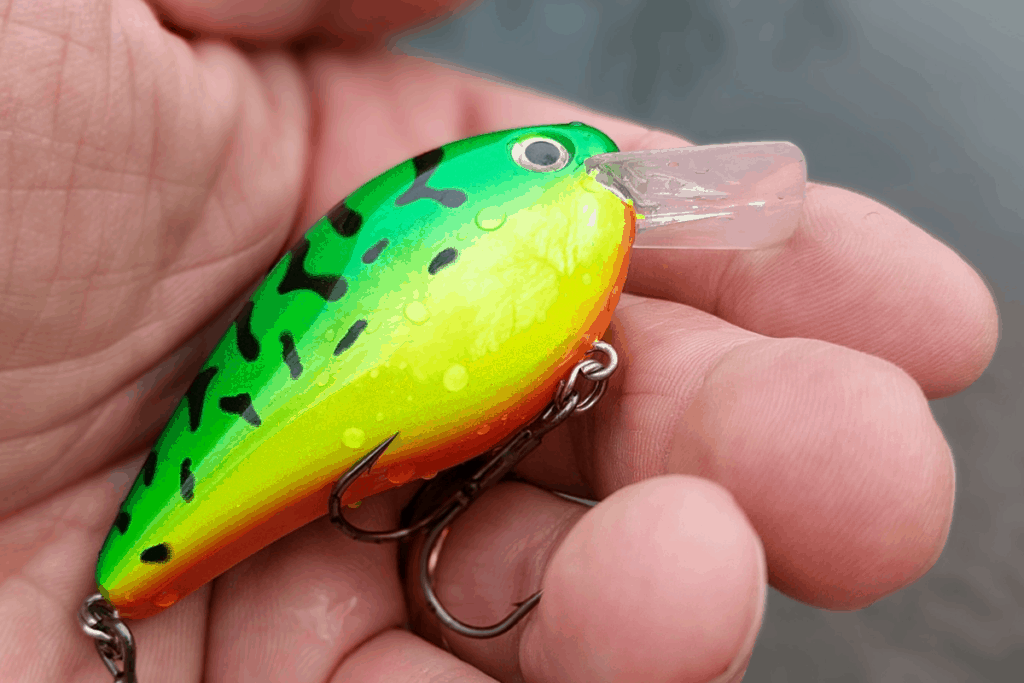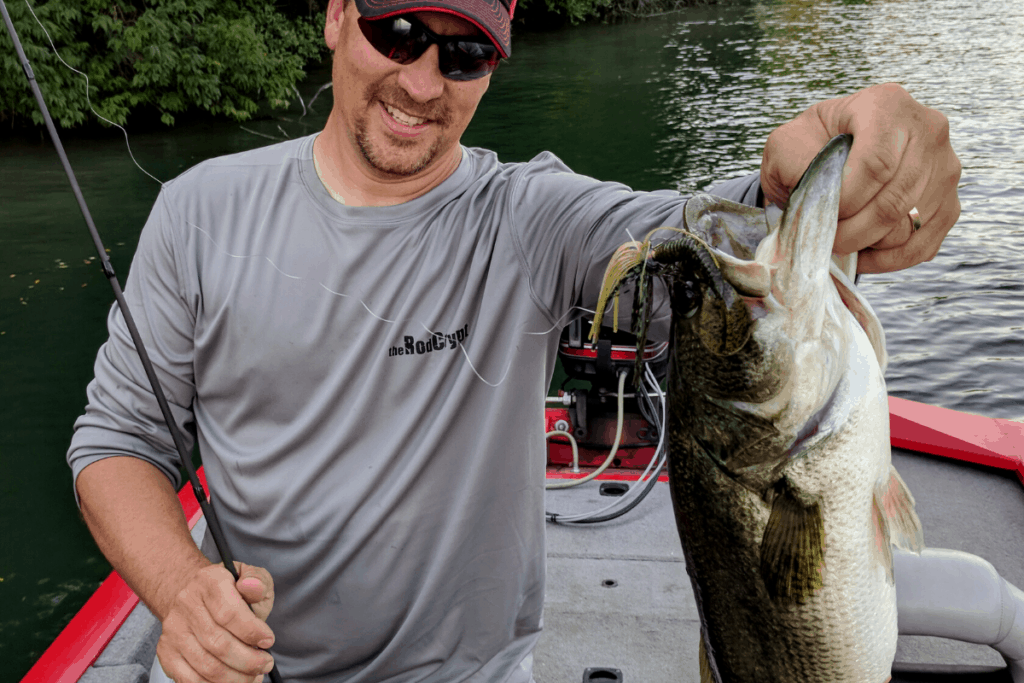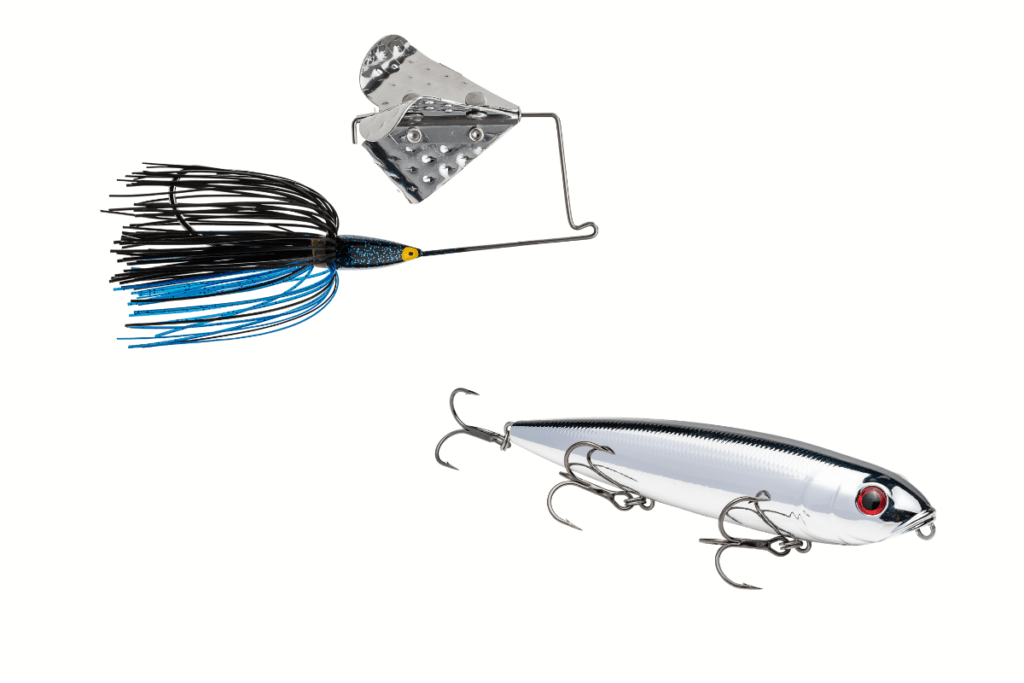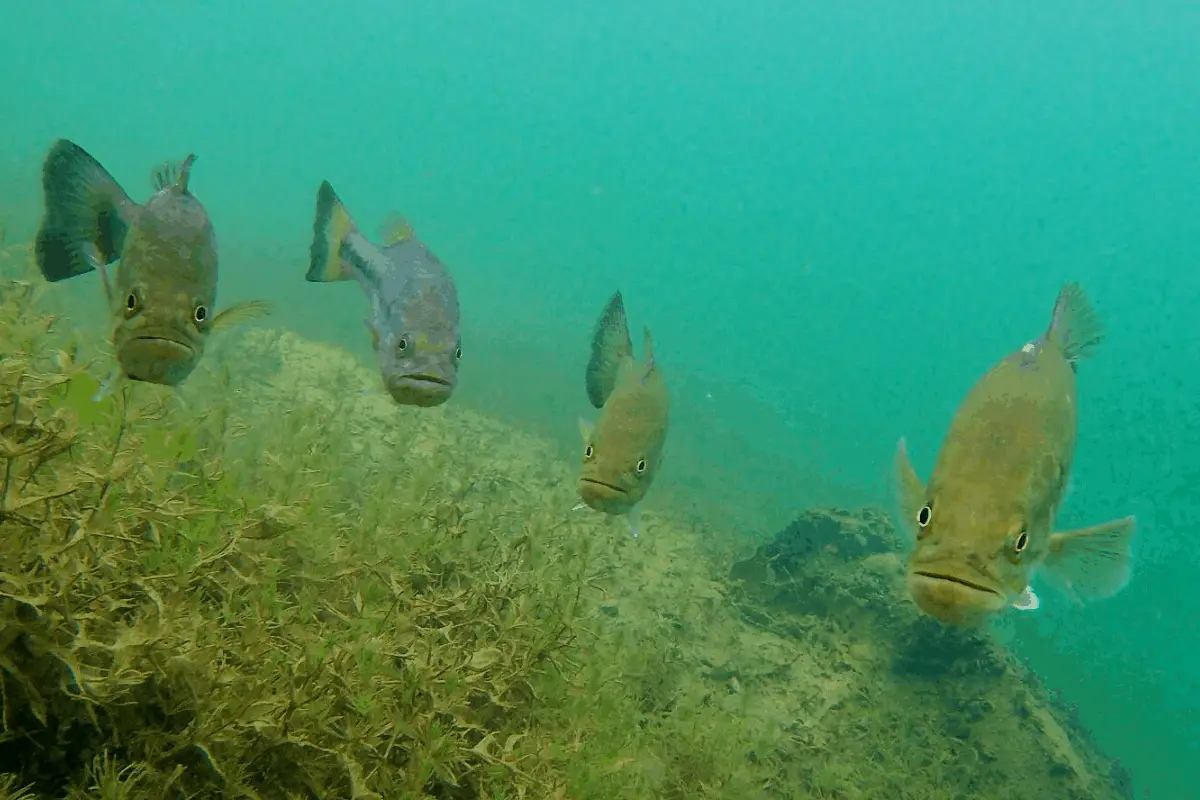Creating a gameplan to locate and then catch summer bass is a key strategy for having a successful day on the water – even when it is hot.
To search for bass on those scorching, summer days, use a rotation of horizontal moving lures and vertical presentations. Horizontal lures, like a swim jig, crankbait, and a topwater, will coax the bass into revealing themselves. Once you have found some fish it is often better to switch to vertical presentations, such as a drop shot or Texas rig to entice them into biting.
Whether you fish from a boat, or walk along the shore, keeping this strategy at the forefront of your summer bass fishing approach will make for some excellent days on the water.
When Searching is More Than Just Catching
The best bass anglers in the world are cognizant of this approach. In order to catch our favorite game fish, you first need to find them. Most days on the water mean that searching requires different lures, techniques, and strategies than actually catching them.
The goal is to get a bass to show themselves. If you catch the fish during the searching process, that is a bonus that helps you to dial in what they want a little sooner.
A Horizontal Presentation to Find Summer Bass
If you hit the water and are not real sure where to begin, then choosing a lure that is presented horizontally will be the most efficient at covering water. The goal is to get a bass to show where they are hiding.
In the summer, a single 14” fish that follows your lure may reveal a school that is nearby. This school very likely has some quality bruisers mixed in.
My Favorite Horizontal (searching) Lures
These three lures have been my go-to baits when I need to find bass and cover water.
Some Sort of Crankbait
I say “some sort” because I will mix up which crankbait based on what type of lake or river I am fishing.
Deep, rocky impoundments are dynamite locations for a traditional deep diver. I want to choose a lure that will run just out of sight and pound the bottom as long as possible.
This may mean that I choose a crankbait that runs a little deeper than my target depth.
If I can see into the water four feet I want a lure that will run deeper than that. If I can see fifteen feet, it is time to pull out a crankbait that will run twenty. Summer bass love to hang in the shadows. They can prowl just out of sight yet move up and chase prey when needed.

Squarebill Crankbait
If I am fishing a lake with dirtier water, or a river system, then I am likely searching for bass with a squarebill crankbait.
This lure is a bass magnet and is easily burned to elicit reaction strikes from fish that are just loafing. It is almost impossible to reel this lure too fast. It also slams into wood and rocks with force and easily deflects without becoming snagged.

Have Some Vegetation? A Swim Jig Rules
If the water that I am fishing is full of vegetation, I will put down the crankbait as my search lure and pick up a swim jig.
These lures work through weeds with ease and can be fished from top-to-bottom. The variety of plastic trailers that can be placed on them allow anglers to match the water clarity. Bulkier soft plastics with more appendages will create a louder sound signature than something such as a single tail grub.
Lots of vegetation also means sunfish are present. Swim jigs excel at matching this key forage base.
If the vegetation is emergent, or too thick, a swim jig will not be the best choice. In those instances a hollow-body frog will find its way on the end of my rod to locate bass.

A Topwater Lure
My third choice for a horizontal, searching lure is a topwater.
These venerable bass locators can be used all day during the summer, not just during the lowlight hours.
Bass are curious creatures. They will pull out of the thickest cover to come and investigate something struggling along the surface. They may not always eat it – but that doesn’t matter when searching. You just want the fish to reveal where they are hanging out.
On cloudier days with a little chop on the water, my topwater of choice will be some sort of walking lure – like a Sexy Dawg. When the sun is high, no clouds, and slick water, I prefer to throw a popper. This lure can sit in the tiniest patches of shade for a long time and coax curious bass into hitting.
A buzzbait is another summer favorite. It elicits a better quality bite than a popper and can be altered to make different squeaks as it is retrieved. Experimenting with retrieve speed and pressing the blade against the arm can make a noticeable impact on what type of bite and how many bites an angler gets.
Once Bass are Located
I use these horizontal lures to search, and hopefully catch a few, but I use them as tools to locate a school of summer bass that I can then fish deliberately and intentionally with a slower presentation.
This is where a vertical offering shines.
Presentations like a Ned Rig, Shaky Head, Wacky Rig, etc., are all excellent tools for getting multiple bites from a school of fish – but these are not always the best lures to cover water and find bass.
It really is a one-two-punch that savvy anglers can utilize to make those tough bluebird days of summer more productive.
It’s a lot like hunting for whitetail deer. Bow hunters will read the sign, scout the woods, and put together all the information to then sit in the “perfect” spot. That is how I like to use searching lures followed up by vertically presented offerings.
How to Work the School of Bass
Once the bass are located, there are several approaches that can allow you to catch as many bass from it as possible.
The first soft plastic tossed into the group usually will get a bite on the initial drop. When the school is activated, the same lure will catch multiple fish for a few minutes.
Once the bite slows down, change to another vertical presentation. Follow up a wacky rig with a Ned Rig. Toss in a drop shot. Mix in a shaky head. You get the idea.
A school of bass can be activated more than once.
Also, be sure to widen the radius of where you are fishing. The school may move slightly deeper or up under some cover. If the school is actively chasing bait there is a good chance the group will move a long ways and often. Keep an eye on surface activity to follow them.
If the school of bass is holding tight to an area, but stop biting, you can always let them rest and then come back. Smallmouth bass are especially on-and-off again predators.
Final Thoughts
Enjoy the process of searching for summer bass. The rewards are great, but it can take some time to find them. Persevere through the empty casts knowing that each presentation is one closer to having an amazing day on the water.
- Use a horizontal lure to locate bass
- Use a vertical lure to work the school
- Be aware of the bass repositioning
- Mix up lures to keep the bite active
Drop a comment below and let me know what some of your favorite searching lures are.
Tight lines. Be safe and make sure to encourage someone today. You never know how you may change their life forever.
Isaiah 6:8

